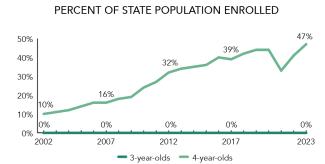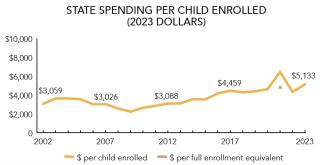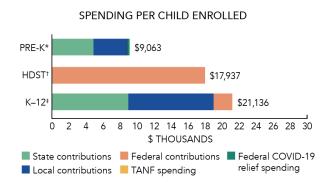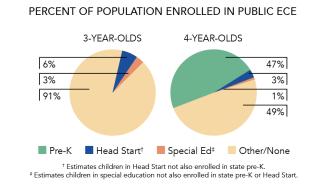
State of Preschool
Maine
Access Rankings
Resource Rankings
Total Benchmarks Met
Overview

During the 2022-2023 school year, Maine preschool enrolled 6,237 children, an increase of 646 from the prior year. State spending totaled $30,121,111, with an additional $1,894,744 in federal recovery funds to support the program, up $7,820,830 (32%), adjusted for inflation, since last year. State spending per child equaled $5,133 in 2022-2023, up $806 from 2021-2022, adjusted for inflation. Maine met 9 of 10 quality standards benchmarks.
What's New

In 2022, ARP funding was committed by Maine’s governor and legislature to support public Pre-K expansion. This allowed ten school administrative units to open or expand current offerings as well as support new team members at the state level. This funding will continue to support new and expanded programming in 2023-24 and will start or expand current offerings and add another team member at the state level. Legislation passed in 2023 directs the formation of a state level commission to study funding public preschool as well as the Maine Department of Education (DOE) to study credentialing pathways and to annually report back to the legislature on public preschool.
Maine’s Department of Health and Human Services, in partnership with Maine’s Department of Education, received an $8 million Preschool Development Grant Birth through Five (PDG B–5) renewal grant in December 2022 to build needed infrastructure and capacity to create a more coordinated, efficient, and high-quality mixed delivery system to ensure children enter Kindergarten prepared to succeed in the early elementary years. Intended outcomes of the expansion effort include engaging a diverse group of stakeholders to advise the development of policy and programming for more fully utilizing Maine’s mixed-delivery system to reach the goal of universal public pre-K. Additionally, PDG B–5 funding will support the addition of a Pre-K Partnership Specialist position to help cultivate partnerships between school systems and community providers to provide public pre-K. Attention will also be paid to professional learning related to high-quality programming and transitions between pre-K and the early elementary years.
Background
Maine established its Two-Year Kindergarten initiative in 1983 by allocating resources to local districts through the school funding formula. Since 2007, state-funded programs for 4-year-olds have been separately defined as the Public Preschool Program (PPP), still funded through Maine’s school funding formula, with a distribution of funds to 152 of the 197 (77%) school administrative units (SAUs) that operate kindergarten.
PPP classrooms function as either stand-alone programs located in public schools or SAUs partner with licensed community-based child care programs or Head Start agencies. Schools are required to provide a local match to draw down a per-pupil state subsidy. The required local match is part of the school funding formula based on property value.
Maine’s Public Preschool Program Standards, promulgated as a regulation in December 2014, outlined programmatic changes including reduced child-staff ratio and group size, the use of evidence-based curricula, and child screening and assessments.
Maine Public Preschool Program
Access
Resources
| Total state pre-K spending | $32,015,855 |
| Local match required? | Yes |
| State Head Start spending | $1,190,007 |
| State spending per child enrolled | $5,133 |
| All reported spending per child enrolled* | $9,063 |

*Pre-K programs may receive additional funds from federal or local sources that are not included in this figure. †Head Start per-child spending includes funding only for 3- and 4-year-olds. ‡K–12 expenditures include capital spending as well as current operating expenditures.
Maine Quality Standards Checklist
| Policy | Requirement | Benchmark | Meets Benchmark? |
|---|---|---|---|
For more information about the benchmarks, see the Executive Summary and the Roadmap to State pages. | 9benchmarks met | ||
| Early Learning & Development Standards Benchmark | Comprehensive, aligned, supported, culturally sensitive | Comprehensive, aligned, supported, culturally sensitive | |
| Curriculum Supports Benchmark | Approval process & supports | Approval process & supports | |
| Teacher Degree Benchmark | BA | BA | |
| Teacher Specialized Training Benchmark | ECE | Specializing in pre-K | |
| Assistant Teacher Degree Benchmark | Educational Technician II (at least 9 ECE credits) | CDA or equivalent | |
| Staff Professional Development Benchmark | 6 credit hours/5 years (teachers), 3 credits hours/5 years (assistants) | For teachers & assistants: At least 15 hours/year; individual PD plans; coaching | |
| Maximum Class Size Benchmark | 16 (4-year-olds) | 20 or lower | |
| Staff to Child Ratio Benchmark | 1:8 (4-year-olds) | 1:10 or better | |
| Screening & Referral Benchmark | Vision, hearing, health & more | Vision, hearing & health screenings; & referral | |
| Continuous Quality Improvement System Benchmark | Structured classroom observations; Data used for program improvement | Structured classroom observations; data used for program improvement | |
